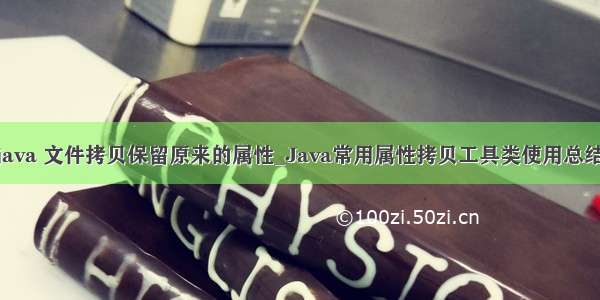
开头聊几句
1、网上很多的技术文章和资料是有问题的,要学会辨证的看待,不能随便就拿来用,起码要自己验证一下
2、关注当下,关注此刻,如果你真正阅读本篇文章,请花几分钟时间的注意力阅读,相信你会有收获的
3、文中代码没有使用图片展示,可能存在阅读排版错乱问题,请见谅,因为可能考虑到有其他伙伴需要拷贝代码,这样比较方便
Java常用属性拷贝工具类使用总结
对项目中经常使用的属性拷贝工具类进行总结:
mons.beanutils.BeanUtils
mons.beanutils.PropertyUtils
org.springframework.beans.BeanUtils
本文使用的工具类对应的版本:
commons-beanutils:1.9.4
spring-beans:5.0.7.RELEASE
字段和属性
首先明确下在Java中字段和属性的区别。
属性是不是类里最上边的那些全局变量吗?比如:
public class UserTest{
private String userName;
private String password;
public String getUserName() {
return userName;
}
public void setUserName(String userName) {
this.userName = userName;
}
public String getPassword() {
return password;
}
public void setPassword(String password) {
this.password = password;
}
public String getHello() {
return "hello";
}
public void setHello(String str) {
}
}
上面 private String userName;private String password;。准确的来说它们应该称为:字段,而不是本次要讲的属性。
下面简述一下:什么是Java中的属性?
Java中的属性(property),通常可以理解为get和set方法,而字段(field),通常叫做“类成员”,或“类成员变量”,有时也叫“域”,理解为“数据成员”,用来承载数据的。
直白点就是Java中的属性是指:设置和读取字段的方法,也就是平常见到的set和get方法。只要是set和get开头的方法在Java里都认为它是属性(请注意这句话,等下后边会写代码做验证)
属性名称:就是set和get方法名 去掉"set"和"get"后的内容
比如:
public void setUserName(String userName) {
this.userName = userName;
}
它的属性名称是:userName(也就是方法名称”setUserName”去掉“set”)
当然 setUserName和 getUserName 方法是指同一个属性 UserName,
这里再次提醒:字段和属性不是同一个东西。
代码验证属性
上面代码中还有一个 getHello 和 setHello , JDK 中有个API Introspector
获取的是java.beans.BeanInfo 类。这个类可以通过
java.beans.BeanInfo#getPropertyDescriptors : 获取java bean 所有的属性。
public static void main(String[] args) throws IntrospectionException {
BeanInfo beanInfo = Introspector.getBeanInfo(UserTest.class);
// 得到类中的所有的属性描述器
PropertyDescriptor[] pds = beanInfo.getPropertyDescriptors();
System.out.println("属性的个数:" + pds.length);
for (PropertyDescriptor pd : pds) {
System.out.println("属性:" + pd.getName());
}
}
结果:
属性的个数:4
属性:class
属性:hello
属性:password
属性:userName
上面多了一个 class ,原因很简单,因为Object类是所有类的父类,Object类里有个方法叫 getClass();
所以这也验证了咱们刚才说的: “只要是set或者get开头的方法都叫属性”
使用说明
default (即默认,什么也不写): 在同一包内可见,不使用任何修饰符。使用对象:类、接口、变量、方法。
public : 对所有类可见。使用对象:类、接口、变量、方法
private : 在同一类内可见。使用对象:变量、方法。 注意:不能修饰类(外部类)
protected : 对同一包内的类和所有子类可见。使用对象:变量、方法。 注意:不能修饰类(外部类)
org.springframework.beans.BeanUtils#copyProperties
1.基本类型和包装类型会自动转换, 方法名称相同,返回值类型和参数类型不同,不进行复制,也不报错_
2.支持指定忽略某些属性不复制
3、支持类的修饰符 default 、 public
mons.beanutils.PropertyUtils#copyProperties
1.基本类型和包装类型会自动转换
2.方法名称相同,返回值类型和参数类型不同,复制失败,会报错,如下:
_argument type mismatch - had objects of type "java.lang.Double" but expected signature "java.lang.String"
3.只支持类的修饰符 public,如果是default 则直接不会进行转换(注意内部类复制也要加public)
mons.beanutils.BeanUtils#_copyProperties
1.基本类型和包装类型会自动转换
2.方法名称相同,返回值类型和_ _参数类型不同,不复制,不报错
3.只支持类的修饰符 public,如果是default 则直接不会进行转换(注意内部类复制也要加public)
tips: Spring和apache的_copyProperties_属性的方法源和目的参数的位置正好相反,所以导包和调用的时候都要注意一下。
// Apache
public static void
copyProperties(final Object dest, final Object orig)
// Spring
public static void
copyProperties(Object source, Object target)
摘要总结:Spring是在次数增多的情况下,性能较好,在数据较少的时候,性能比PropertyUtils的性能差一些。PropertyUtils的性能相对稳定,表现是呈现线性增长的趋势。而Apache的BeanUtil的性能最差,无论是单次Copy还是大数量的多次Copy性能都不是很好。
根据上面的具体的分析还是使用 :org.springframework.beans.BeanUtils#copyProperties
原因:
1.这个方法在复制的时候不会因为属性的不同而报错,影响代码执行
2.性能方面也相对较好
其他Apache的两个,
1、mons.beanutils.PropertyUtils#copyProperties 复制会直接报错
2、mons.beanutils.BeanUtils#copyProperties 性能相对较差
原理探索
核心本质都是使用反射实现。具体的实现代码稍有不同。
Spring#BeanUtils
private static void copyProperties(Object source, Object target, @Nullable Class> editable,
@Nullable String... ignoreProperties) throws BeansException {
Assert.notNull(source, "Source must not be null");
Assert.notNull(target, "Target must not be null");
Class> actualEditable = target.getClass();
if (editable != null) {
if (!editable.isInstance(target)) {
throw new IllegalArgumentException("Target class [" + target.getClass().getName() +
"] not assignable to Editable class [" + editable.getName() + "]");
}
actualEditable = editable;
}
PropertyDescriptor[] targetPds = getPropertyDescriptors(actualEditable);
List ignoreList = (ignoreProperties != null ? Arrays.asList(ignoreProperties) : null);
for (PropertyDescriptor targetPd : targetPds) {
Method writeMethod = targetPd.getWriteMethod();
if (writeMethod != null && (ignoreList == null || !ignoreList.contains(targetPd.getName()))) {
PropertyDescriptor sourcePd = getPropertyDescriptor(source.getClass(), targetPd.getName());
if (sourcePd != null) {
Method readMethod = sourcePd.getReadMethod();
if (readMethod != null &&
ClassUtils.isAssignable(writeMethod.getParameterTypes()[0], readMethod.getReturnType())) {
try {
if (!Modifier.isPublic(readMethod.getDeclaringClass().getModifiers())) {
readMethod.setAccessible(true);
}
Object value = readMethod.invoke(source);
if (!Modifier.isPublic(writeMethod.getDeclaringClass().getModifiers())) {
writeMethod.setAccessible(true);
}
writeMethod.invoke(target, value);
}
catch (Throwable ex) {
throw new FatalBeanException(
"Could not copy property '" + targetPd.getName() + "' from source to target", ex);
}
}
}
}
}
}
1、获取 目标对象 所有的属性 targetPds
PropertyDescriptor_[] _targetPds = getPropertyDescriptors(actualEditable);
2、循环 targetPds ,并在源对象取出对应的属性
PropertyDescriptor sourcePd = getPropertyDescriptor(source.getClass(), targetPd.getName_())_;
3、r如果不是修饰不是public,暴力反射 ,然后使用对属性进行设值
setAccessible_(true);// 暴力反射
writeMethod.invoke(target, value)_;
### mons#BeanUtils
mons.beanutils.BeanUtilsBean#copyProperties
简单截取核心代码:
// mons.beanutils.BeanUtilsBean#copyProperties
final PropertyDescriptor[] origDescriptors =
getPropertyUtils().getPropertyDescriptors(orig);
for (PropertyDescriptor origDescriptor : origDescriptors) {
final String name = origDescriptor.getName();
if ("class".equals(name)) {
continue; // No point in trying to set an object's class
}
if (getPropertyUtils().isReadable(orig, name) &&
getPropertyUtils().isWriteable(dest, name)) {
try {
final Object value =
getPropertyUtils().getSimpleProperty(orig, name);
copyProperty(dest, name, value);
} catch (final NoSuchMethodException e) {
// Should not happen
}
}
}
// mons.beanutils.BeanUtilsBean#copyProperty
getPropertyUtils().setSimpleProperty(target, propName, value);
// mons.beanutils.PropertyUtilsBean#setSimpleProperty
invokeMethod(writeMethod, bean, values);
1、 获取的是源对象的所有的属性
final PropertyDescriptor[] origDescriptors = getPropertyDescriptors(orig);
2、如果属性是class,不复制
if ("class".equals_(name)) { continue; // No point in trying to set an object's class}_
3、循环源对象的属性,做一些检验
copyProperty(dest, name, value);
1、会检验目标对象是否有源对象的属性,没有跳过
2、获取属性的名称类型
4、然后给目标对象设置,最终还是使用反射
method.invoke_(bean, values)_;
mons#PropertyUtils
mons.beanutils.PropertyUtilsBean#copyProperties
简单截取核心代码:
// mons.beanutils.PropertyUtilsBean#copyProperties
final PropertyDescriptor[] origDescriptors =
getPropertyDescriptors(orig);
for (PropertyDescriptor origDescriptor : origDescriptors) {
final String name = origDescriptor.getName();
if (isReadable(orig, name) && isWriteable(dest, name)) {
try {
final Object value = getSimpleProperty(orig, name);
if (dest instanceof DynaBean) {
((DynaBean) dest).set(name, value);
} else {
setSimpleProperty(dest, name, value);
}
} catch (final NoSuchMethodException e) {
if (log.isDebugEnabled()) {
log.debug("Error writing to '" + name + "' on class '" + dest.getClass() + "'", e);
}
}
}
}
// mons.beanutils.PropertyUtilsBean#invokeMethod
method.invoke(bean, values);
1、 获取的是源对象的所有的属性
final PropertyDescriptor[] origDescriptors = getPropertyDescriptors(orig);
2、循环源对象的属性,然后给目标对象设置,最终还是使用反射
总结
结合使用说明以及相关的性能和原理分析,建议使用 org.springframework.beans.BeanUtils#copyPropertie
参考资料
Java编程技术乐园:分享干货技术,每天进步一点点,小的积累,带来大的改变!
扫描关注,后台回复99.9%的伙伴都很喜欢
















